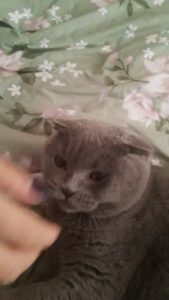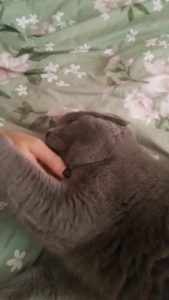Scottish Fold Bites You? 10 Tips to Prevent Biting Problems
Does your Scottish Fold cat bite you when you try to pet it? Mine used to do exactly that. It was strange, as all I wanted to give her is my love, but she couldn’t understand it I guess. What’s the point of having a beautiful kitten like the Scottish fold if she tries to bite you when you are petting her?
I tried to understand this phenomenon, and basically, understand why the Scottish Fold doesn’t like touching and petting all the time. I will tell you exactly how to treat this kind of behavior if your cat does the same thing and how to (better) react to the biting and scratching. All in all, the problem reduces to two questions:
Why doesn’t my Scottish Fold like petting her?
 She actually does, but remember that Scottish Fold is a breed that strongly relates to the British Shorthair. These types of cats don’t need that much love and care. They will find a way to show you if they need attention, but they don’t like petting them all the time.
She actually does, but remember that Scottish Fold is a breed that strongly relates to the British Shorthair. These types of cats don’t need that much love and care. They will find a way to show you if they need attention, but they don’t like petting them all the time.
Most people pet them too often and too aggressive. Scratching their head for 10-20 seconds may be enough for a Scottish Fold or British Shorthair.
For example, most people don’t know that a cat’s whiskers are very sensitive. The cats use the whiskers as a sensory tool. They need to “see” in dark places and they can move around using whiskers for touch senses. Given this fact, the whiskers are very sensitive and tickle the cats when you pet them.
We can see that most of the whiskers are on the cat’s muzzle, but they have whiskers in other parts of their body too. As a matter of fact, on most of the body including paws, back, head and belly. They are smaller than the ones on the muzzle, but they are still there ready to feel objects in the dark. If you look closer you can maybe see some of them.
We really need to avoid them when petting the Scottish Fold. We will develop this fact later.
Why does my Scottish fold bite?
Tickling
 That’s a good question. It relates to the facts given above. What you need to understand first is that “Love Bitting”, as many people name it, doesn’t exist. Do you bite your fiance, wife or husband to show him, love? Maybe you do, but the animals, including cats, don’t. They bite because they feel uncomfortable and they want to show it to you by biting.
That’s a good question. It relates to the facts given above. What you need to understand first is that “Love Bitting”, as many people name it, doesn’t exist. Do you bite your fiance, wife or husband to show him, love? Maybe you do, but the animals, including cats, don’t. They bite because they feel uncomfortable and they want to show it to you by biting.
So, imagine that you are laying in the bed, relaxing for a couple of minutes. Life is good! But, someone comes and starts tickling you, and they won’t stop. What do you do? Obviously, you can say nothing and move to another room in the house or tell them to stop, right? Well, a cat doesn’t do that. Like other animals, they want to show their dominance and react in a more “aggressive” way: they bite or scratch.
You can’t condemn them, they are only reacting to the situation. But, nobody likes that. I remember that a visitor I had was actually irritated because my Scottish Fold was so cute, but he couldn’t pet it or show his love. That’s annoying. I will give you some tips on how you can prevent the biting and better understand your cat.
If your Scottish Fold or your cat doesn’t mind petting or scratching, it means it’s less sensitive. That’s neither a good or a bad fact for her, but it’s good for you. You are lucky, enjoy!
Domination
Another reason why Scottish Folds bite, in my opinion, is that they want to dominate the place. If they feel like you are invading their space and don’t let them do what they want, they will probably react. (usually, by biting or scratching you). If you see that he or she doesn’t like what you’re doing, stop.
How to prevent the Scottish Fold from biting?
Well, you first need to understand how your cat feels and communicates. Then, we can watch for certain signs and act properly.
Scottish Fold Tail Behaviour
 When dogs are happy, they move their tails back and forth. It’s simple and if you played with a dog before you already knew this. Scottish folds and cats in general, are different. Tail movement on a Scottish Folds smells as a warning.
When dogs are happy, they move their tails back and forth. It’s simple and if you played with a dog before you already knew this. Scottish folds and cats in general, are different. Tail movement on a Scottish Folds smells as a warning.
If your cat starts to move the tail back and forth aggressively (or fast) it means he or she doesn’t like something. If you are petting them at the moment, you should probably stop. It’s a sign that the Scottish fold doesn’t enjoy the petting.
Scottish Fold Eyes Behaviour
Other signs that come simultaneously with the tail movement are the eyes and pupils. If your Scottish fold is relaxed, the eyes will be more closed than opened and the pupils will be relaxed or narrow. If the pupils start to dilate they don’t feel relaxed.
So if you see this sign when you are petting them, you are probably doing something wrong.
Scottish Fold Fur
Another subtle (or not) sign that Scottish Folds present when he or she doesn’t like something is the fur standing up. If you are petting him or her at the moment, it’s time to stop.
Scottish fold Skin Ripples
It’s also related to the fur sign. If your cat’s skin ripples stand up, it’s a warning sign.
One more personal tip
I observed that my Scottish Fold doesn’t mind keeping my hand on her as long as she doesn’t feel that I control the area. Usually, keeping your hand on the Scottish Fold (eg. when you are watching a movie, or doing something) will make her feel safe. On the other hand, if you try to pet it all the time, it will probably react in a negative way: biting, scratching. In the best case scenario, the Scottish Fold will leave that area.
Also, she does mind the hand if I pet her aggressively right before. She remembers and wants to get back in control. She likes to dominate the place and feel like she’s the boss.
Examples
I recorded some moments with my Scottish Fold cat.
In the video below, I and my girlfriend were playing quite aggressively with her. She obviously didn’t like that and responded by biting. Not nice!
Here, another approach. She was sitting in silence, and I came very gently. I approached her and pet her for less than 1 minute. She liked that and didn’t even bother to respond or “say” something. Be gentle and everything will be okay.
Tips to prevent Scottish Fold from bitting you
First, make sure you understand the tips given above. You need to understand how your cat communicates. As cats can’t speak (obviously) they can’t tell you what they like and what they don’t. They will at most, give you a sign that you need to interpret. If you spot the signs well and you adapt, so will your cat.
- Make sure you stop when the Scottish fold doesn’t enjoy it
- Don’t overdo it. Scottish Folds and British Shorthair cats don’t need a lot of love.
- Test the waters. If your cat doesn’t enjoy back scratching, don’t do it. Find other spots that he or she enjoys.
- Be gentle: Move your hands slow and predictable
- Watch for the signs and stop the petting if needed.
- Punishing bad behavior, and rewarding good behavior is another method. (I don’t personally like it as it’s more of an animal training tip). The punishing and rewarding must be right after the cat’s actions
- Be patient – don’t pet them often. They will come to you when they need some attention. But, this doesn’t mean they will want 10 minutes of scratching and grooming. Give them less than they expect at first. They will come back for sure.
- Ignore the biting. Getting angry won’t solve anything, neither screaming at your cat. It may stop the biting but your cat may feel fearful and anxious near you. You don’t want that to happen.
- Let it go. When your cat starts biting, stop and let it alone.
How to pet the Scottish Fold?
- Start gently with a soft chin-scratch. …
- Scottish Fold particularly like the area before his ears
- Avoid the whiskers and scratch her right before them
- Pet the Scottish Fold using the back of the hand on the side of the face
- Continue very very gently with the rest of the body, but if he/she doesn’t like it, stop immediately!
Conclusion
Your Scottish Fold is a part of your heart. He or she certainly loves you, but they won’t show you this by biting. Scottish Folds like petting them and grooming but in a limited quantity. If you find the spots where your cat likes scratching you will be able to avoid the biting.
In my opinion, punishing and reward is a good way to prevent your Scottish from biting but can affect the cat’s behavior (showing fear or anxiety around you) and that’s why I don’t recommend it.
My opinion is based on my Scottish Folds that bites if you scratch her on her belly, back and upper legs. She enjoys touching the lower legs part gently and soft. Also, she enjoys scratching her head, cheeks and under the chin.
I want to know your opinion. Like humans, cats are not all the same. What works on a cat may or may not work on another. Following these tips, you can probably find the best way to handle this situation. If you have a Scottish Fold with biting problems and solved them (or not) please post a comment below so everyone can see your opinion). Scottish Folds are great, enjoy them!